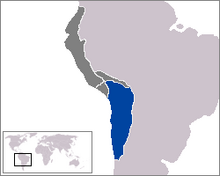Qullasuyu
Appearance
This article needs additional citations for verification. (January 2013) |
| Qullasuyu | |||||||
|---|---|---|---|---|---|---|---|
Suyu of Inca Empire | |||||||
| 1438–1535 | |||||||
 Qullasuyu within the Inca Empire | |||||||
| Capital | Hatunqulla | ||||||
| Historical era | Pre-Columbian Peru | ||||||
• Established | 1438 | ||||||
| 1535 | |||||||
| 1541 | |||||||
| Subdivisions | |||||||
| • Type | Wamani | ||||||
| |||||||
Qullasuyu (
Huayna Cápac
in the sixteenth century.
Recently, there have been movements to form a "Greater Qullasuyu" (or Qullana Suyu Marka) which would incorporate a territory similar to the former

Etymology

From
suyu (region, quarter of the Inca Empire), with the meaning of "southern region".[4]
Wamani
Each suyu was divided into wamani, or provinces. Qullasuyu included the wamani of:
- Arica or Arika
- Cana or Kana
- Canche or Kanche
- Caranga or Karanka
- Caruma
- Cavina or Kawina, whose people were “Incas by privilege”
- Chicha
- Cochabamba or Quchapampa
- Collagua
- Lipe
- Locumba
- Lupaqa
- Moquegua
- Pacajesor Pacasa
- Qolla Urcosuyu or Qulla Urqusuyu
- Sama
- Tambo or Tampu
- Tarata
- Ubina
- Yampará or Yampara
See also
- Antisuyu
- Chinchaysuyu
- Kuntisuyu
- Oroncota, Yampara settlement and Inca fortress in Bolivia
- Organization of the Inca Empire
- The Chilean Inca Trail
References
- ^ D’Altroy, Terence N. (2005). The Incas. Blackwell Publishing: Malden, p. 86-87
- ^ D’Altroy, Terence N. (2005). The Incas. Blackwell Publishing: Malden, p. 42-43, 86–89
- ^ Steward, Julian H. & Faron, Louis, C. (1959). Native Peoples of South America. McGraw-Hill: New York, p. 185-192
- ^ Teofilo Laime Ajacopa, Diccionario Bilingüe Iskay simipi yuyayk'ancha, La Paz, 2007 (Quechua-Spanish dictionary)
- ^ D’Altroy, Terence N. (2005). The Incas. Blackwell Publishing: Malden, p. 42-43, 86–89
- ^ Steward, Julian H. & Faron, Louis, C. (1959). Native Peoples of South America. McGraw-Hill: New York, p. 185-192
